 A few months ago, back when Tiger was chasing down the number one ranking, I got an idea: Why not graph out the trajectories of the world’s top players over their careers, using the official data available on the Official Golf World Rankings website? At the time, the OWGR site only provided downloadable player data back until about 2003, which is fine for the careers of Rory McIlroy and Brand Snedeker, but, as you’ll see below, the Phil Mickelson graph from 2003 on is relatively boring.
A few months ago, back when Tiger was chasing down the number one ranking, I got an idea: Why not graph out the trajectories of the world’s top players over their careers, using the official data available on the Official Golf World Rankings website? At the time, the OWGR site only provided downloadable player data back until about 2003, which is fine for the careers of Rory McIlroy and Brand Snedeker, but, as you’ll see below, the Phil Mickelson graph from 2003 on is relatively boring.
Thankfully, when I looked at the data again this month, they had expanded the data all the way back to their career beginnings. Ernie Els, for instance, the oldest player I tracked, has data going back to 1989.
So this is what I decided to do: I got the points tally and OWGR ranking data for the top 15 players in the world as of July 7th (a while ago, I know, but it takes a while to compile and graph all of the data), and graphed both sets. The OWGR points and rankings are through that same day, so they do not include Phil Mickelson’s Scottish Open win or his British Open title. Tiger’s Bridgestone win is similarly unrepresented.
I decided to normalize the y-axes with a maximum of 25 points and a 500 ranking for comparison’s sake, though with some of the more consistent golfers (Tiger, Phil, Ernie for much of the mid-2000s) that is a bit to their detriment (in that you can’t see the more slight variations). The x-axes are different for each player, going back to the very beginnings of their pro careers. The OWGR data can get a bit wonky at the very beginnings of the data, which you can see pretty easily in the Tiger and Rory graphs. The y-axes cutoffs do minimize that a bit.
At the beginning I’ve also created two graphs, which superimpose data for all 15 players dating back to 2003.
If graphs aren’t your thing, well, read the captions and enjoy the colors. And if you have to use Excel all day at your job, fear not, for I used the Apple app, Numbers.
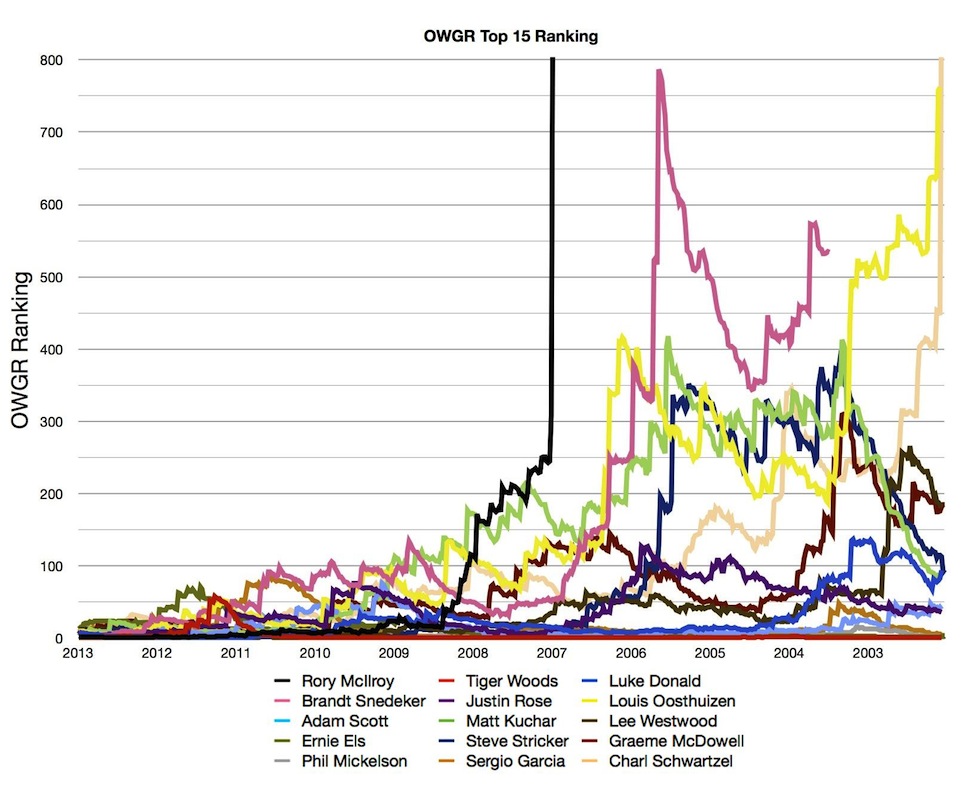
Furthermore, it should be noted that the methods for calculating OWGR points have changed over the years. Before 1996, three years were used in calculating the points total, though since then only two years have been used. The tournament-by-tournament system was altered in 2000, expanding it to more of the field and using more specific decimal values rather than the integer-only points total that was used prior. In 2001, they changed from doubling the points from the most recent 12 months to a more gradual system of point decay. This was refined further in 2007.
Though Tiger’s rankings graph is impressive, it’s the insanity of his points graph that’s truly amazing. Look at it! He reached a points value so high, I had to cut some of it off just so you could see details in the graphs of his competitors. It’s true that when Tiger exceeded 25 points that OWGR system was different, and I have not the patience to attempt to calculate what it would have been under the current system, but just visually compare the heights he reached versus the peaks of his fellow golfers. If you’ve never appreciated the dominance of Tiger The Golfer, observing that graph is a good place to start.
Tiger Woods turned pro in 1996, and immediately began winning, including his first major, the 1997 Masters. Woods reached the top spot in the world in July of that year.
Woods subsequently underwent his first swing renovation, under Butch Harmon, and won only once in all of 1998, though he did spend a significant portion of the year with the top ranking.
Tiger finally took the top spot back for good in August of 1999, amidst four straight victories to end the year (including the PGA Championship). Winning the U.S. Open and Open Championship the next year, Tiger completed the career grand slam at the age of 24. He kept on winning, including the 2000 PGA Championship (“Yes you May!”) and the 2001 Masters, completing the “Tiger Slam,” as the only player ever to hold the Masters, U.S. Open, British Open, and PGA trophies at the same time.
He threatened the calendar grand slam in 2002, winning the Masters and U.S. Open, but a vicious rainstorm and an 81 on Saturday kept the Claret Jug out of Tiger’s grasp. A month later, he lost the PGA Championship by one shot.
Woods again went to the drawing board with his swing, this time under Hank Haney, in an effort to buoy a left knee that had already required surgery. He went winless in majors for two years as the doubters built up. He was overtaken by Vijay Singh for the top ranking, and even slipped to third as Ernie Els snuck above him.
But 2005 was fruitful for Tiger, who won the Masters over Chris DiMarco thanks to an insane chip-in on the 16th hole. He was also victorious in The Open that year, his second British win at The Old Course. Woods won the British again the next year at Hoylake, as well as the PGA Championship, and finished the 2006 season with six consecutive wins.
His 2007 season included only one major win, the PGA, and injuries early on threatened his 2008. He had his knee scoped after a second-place finish at The Masters, and didn’t play a single event between the surgery and the U.S. Open, which was held at Torrey Pines. Woods pulled the victory out after a 91-hole battle with Rocco Mediate, but knee surgery kept him out the entire rest of the season.
In hindsight, Tiger’s 2009 resembles what we have come to expect from him recently, six PGA Tour wins and a lot of close finishes in majors. He continued that over the first two majors of 2010, between which Hanky Haney resigned as his swing coach. Tiger was first seen working with Sean Foley at the PGA Championship later that year, though Woods finally lost his stronghold over the top ranking in October.
An injury-plagued 2011, in which he fired caddy Stevie Williams and went winless on the PGA Tour, saw Tiger fall to 58th in the world.
But he came back strong in 2012, winning three times, and 2013, which saw Tiger get to four wins faster than any time in his career. Majors, however, have been a different story. Woods has had a penchant for getting off to decent starts, putting himself in a position to make a Saturday charge, and then faltering, sometimes in magnificent fashion on the weekends.
As of this writing, he remains stuck on 14 major victories.
Rory McIlroy has had one of the more typical rises to the top, from a story standpoint. At one point he was poorly ranked, then he won, then he won again, and again, and again, and now he’s ranked not-so-poorly.
McIlroy’s wins thus far include his first Euro Tour win, the 2009 Dubai Desert Classic, his first PGA Tour victory, the 2010 Quail Hollow Championship, and his first two majors, the 2011 U.S. Open and the 2012 PGA Championship.
After establishing himself as a skilled amateur golfer with a T4 in the 1998 Open Championship, Justin Rose struggled early on in his career. That British low amateur put him around 250th in the world, but several years of poor golf skyrocketed him up over 500th. He started 2001 off strong with several runner-up finishes in South Africa, and won his first professional event there a year later, which put him inside the top 50. He won again on the European Tour later that year (as well as once on the Japan Tour), but when he went winless the next three years, he fell steadily in the rankings, at one point reaching above 150th.
He came back strong, winning on the European and PGA Tour of Australasia (no, that’s not a misspelling), and won again in Europe the next year.
After losing ground in the rankings again, he rebounded around the start of the next decade. As he began to play more in America, Rose won his first and second PGA Tour events in 2010, his third in 2011, and his fourth in 2012.
Rose reached third in the world for the first time in his career after finishing second to Tiger Woods in the 2013 Bay Hill Invitational, and cemented that status a few months later with his first major win at the U.S. Open.
Like many of the current members of the top 15, Adam Scott reached a high ranking early on, fell off a bit, and has again reached the top. Scott won several high-profile events at the beginning of his career, including the Alfred Dunhill Championship in 2001, the Qatar Masters in 2002, the Deutsche Bank Championship in 2002, and The Players Championship in 2004. For years Scott was one of the most consistent and highest-ranked players in the world, culminating with the high profile pairing of Scott, Phil Mickelson, and Tiger Woods during the first two rounds of the 2008 U.S. Open.
He went without a win in 2009, which ballooned his world ranking to 76 at one point. But Scott has been on the comeback trail as of late, including his first major victory, the 2013 Masters.
Matt Kuchar has certainly had an interesting career, rankings-wise. Early success as an amateur got him into the 300s, but he quickly fell outside the top 500. His first PGA Tour win at the 2002 Honda Classic helped him break the top 50, though he didn’t cash another PGA Tour winner’s check until 2009. A steady diet of victories and high finishes have kept Kuchar near the top of the world ever since.
That first big dip you see at the beginning of Graeme’s graph is his initial European Tour win at the 2001 Volvo Scandinavian Masters. He won a few times over the next few years, once in 2004, and twice in 2008, but it was really the 2010 U.S. Open that shot McDowell up the world rankings. That was one of three victories in 2010 for McDowell, and though he went winless in 2011 and 2012, two wins so far in 2013 (the Alstom Open de France and the RBC Heritage), have kept him near the top.
Brandt Snedeker spent his early career like many young American professional golfers do: toiling away on the mini-tours, and eventually making his way to the Web.com Tour. His two wins there in 2006 are the Scholarship America Showdown and the Permian Basin Charity Golf Classic, and are responsible for those big dips you see.
He reached his early-career best ranking of 32nd thanks to his first PGA Tour win, the 2007 Whyndham Championship, but went without another big check until 2011. A strong 2012, including two wins and a FedExCup victory, plus an early-season win in 2013, put him inside the top 10.
Attempting to explain and evaluate all of Phil Mickelson’s wins to date would be an exercise in futility, but early on in his career, the cause-and-effect is a bit more obvious. That big drop in his ranking is largely thanks to a PGA Tour win Phil had as amateur, the Northern Telecom Open. He established himself as a consistent winner over the next few years, with two victories in 1993, one in 1994, one in 1995, and four in 1996, which is when he first cracked the top 10.
That small peak around the middle of the decade was thanks to a winless 2003, though his first major, the 2004 Masters, quickly got Phil towards the top of the rankings.
Ailments and infrequent winnings have dropped Phil’s ranking a bit in recent years, but his recent Open Championship win put him back in the familiar number two spot, again behind Tiger Woods.
Though his dip wasn’t as extreme, Luke Donald has had a similar career arc to fellow top golfers Adam Scott, Lee Westwood, and Steve Stricker.
Donald established himself early on, winning the 2002 Southern Farm Bureau Classic (an alternate field PGA Tour event) and the 2006 Honda Classic on the PGA Tour. He also had success in Europe, winning twice in 2004.
But after Donald’s Honda win, he went without a victory check until 2010. He never fell that far, reaching a maximum ranking of 40th, but Donald was (and remains) a non-factor in most majors.
Since the start of the new decade, however, Luke has spent significant time as the game’s most consistent player. From 2010 to 2012, Donald won three times on the PGA Tour, five times in Europe, and once on the Japan Tour (at the relatively prestigious Dunlop Phoenix).
With Tiger flailing through much of 2010 and 2011, Donald one was of four players (the others being Lee Westwood, Martin Kaymer, and Rory McIlroy) to spend top as the world’s top golfer. Many criticized the OWGR’s system for this, asserting that Donald’s lack of majors and low win total should disqualify him from the top spot. This argument, however, doesn’t account for Donald’s extreme consistency over this period; he was a top-10 machine, not to mention the fact that none of his competition was exactly setting the links on fire.
Louis Oosthuizen has one of the more gradual ascension in his points graph, though his ranking has fluctuated a bit more violently. The smooth-swining South African got his first Sunshine Tour win in late 2004, which is the cause for that sizable drop in his ranking. After that he just played steadily better golf, with three Sunshine wins in 2007, one in 2008, one in 2011, and one in 2012 (the latter two were so-sanctioned by the European Tour).
His Euro Tour breakthrough came in 2010, at the Open de Andalucia de Golf, though he really rocketed up the rankings a few months later with a victory at The Open Championship on a rain-soaked Old Course.
As you’ll see below with Lee Westwood’s career, Steve Stricker’s is similar in that he remains winless in majors and spent a significant portion of the mid-2000s playing poor golf.
Stricker, however, never made it to quite the same level as Westwood before his drop-off. He was consistently within the top 50, but Stricker didn’t crack the top 10 until August of 2007, the day after his win at The Barclays, his first victory in six years. Stricker went winless in 2008, but secured his spot near the top with a spate of wins through 2009 and 2012, eight in total (including three victories at the John Deere Classic).
Lee Westwood’s career his marked by two things: his inability to win majors, and the horrific slump he went through in the early 2000s, which is now bookended by long stretches in the top 15, including stints atop the world in late 2010 and early 2011.
Westwood’s first professional win came at the European Tour’s Volvo Scandinavian Masters. With wins on the PGA, Euro, Sunshine, Asia, Japan, and Australasian Tours, as well as several high majors finishes, Westwood quickly made his way towards the top of the world rankings. But by 2001, he had hit a rough spot, and he fell out of the top 100 the next year. Winless on all tours over those two years, Westwood dropped like a rock, peaking (in a bad way) at 266th in the world.
But he came back strong in 2003, with a pair of Euro Tour wins, and although he went winless again over the next three years, Westwood remained firmly inside the top 100. Two wins in 2007 and two in 2009 put him back in the top 10, though he turned it on for real over the next few years. Westwood won the PGA Tour’s St. Jude Classic in 2010 (along with the Nedbank Golf Championship on the Sunshine Tour), though his 2011 record was a bit more worldly, including wins at the Euro Tour’s Ballantine’s Championship, the Asian Tour’s Indonesian Masters and Thailand Golf Championship, and a repeat victory at the Nedbank. He also won twice on 2012.
From 2009 to 2013, Westwood has cracked the top 10 in more than half of the majors he has played, along with a third place finish in the 2008 U.S. Open, in which Westwood was tied with Tiger Woods through 71 holes. Though Westwood was in better shape after his first two shots than Woods, Lee was unable to get his birdie putt to drop, which is really all you need to know about Lee Westwood’s career to date.
As should be obvious, Ernie’s data went back longer than any other player I tracked. The fist OWGR rankings were released just prior to the 1986 Masters, only three years prior to the beginning of Els’ career.
Similar to Sergio Garcia, which you’ll see below, Ernie Els has a very quick ascension to the top of the world. While it took Sergio a handful of events, Els needed just two in 1994: a victory at the Dubai Desert, his first European Tour win which saw him besting runner-up Greg Norman by six strokes, and his first major, the U.S. Open, just a few months later.
Several other wins on the U.S. and European Tours solidified Els’ placement near the top of world, including two Buick Classic wins in 1996 and 1997, and his second U.S. Open victory, also in 1997. Within a year of that event, he reached the top spot in the world, only staying there for a few weeks. He remained a top player through much of the 2000s, though he began to slip towards the middle and end of the decade. Els went winless on the PGA Tour between late 2004 and early 2008, though he remained a steady Euro Tour winner.
After ballooning to a mid-20s ranking, Els’ comeback was buoyed by a win at the WGC-CA Championship at Doral and the Arnold Palmer Invitational in 2010, and he was able to sneak back to sixth in the world. He fell off again, this time even more precipitously, and reached 71st in the world by early 2012, his worst ranking since 1992. But winning tends to cure that sort of illness, and his second Open Championship victory later that year kicked him back into the top 15.
As both of Sergio’s graphs show, Garcia had one of the most precipitous early-career rises ever. He entered 1999 ranked 405th in the world, and finished the season ranked 12th. There were three events that got him there: wins at the Murphy’s Irish Open and Linde German Masters on the European Tour, and a famous second-place finish to Tiger Woods at the 1999 PGA Championship at Medinah. Wins on the European and PGA Tours over the next few years were enough to keep him around the top 15 in the world, though he slipped around 2003 and 2004.
A smattering a wins (2004 EDS Byron Nelson Championship, 2004 Buick Classic, and 2005 Booz Allen Championship on the PGA Tour, and the 2004 Mallorca Classic and 2005 Omega European Masters on the Euro Tour) turned that around, and soon Garcia had ascended to fourth in the world. He had a stellar 2008 season, with wins at the Players Championship on the PGA Tour as well as the Castellò Masters Costa Azahar and HSBC Champions on the Euro Tour. By the end of the season, thanks to several near-misses in late-season FedExCup events with Tiger Woods on the mend, Sergio made it all the way up to second in the world.
But he fell off again, not winning until 2011 on the Euro Tour and 2012 on the PGA Tour, and descended to 85th in the world.
The first thing you’ll notice in Charl’s ranking graph is the big dip in late 2004 from nearly 350 to just over 100. That is in line with his victory at the Dunhill Championship, his first big-time win, and an event that is co-sanctioned by the Sunshine and European Tours. That’s the only big jump in the data, though you can see his gradual increase in points and decrease in ranking coincides with more frequent and high-prestige wins, including the 2011 Masters.


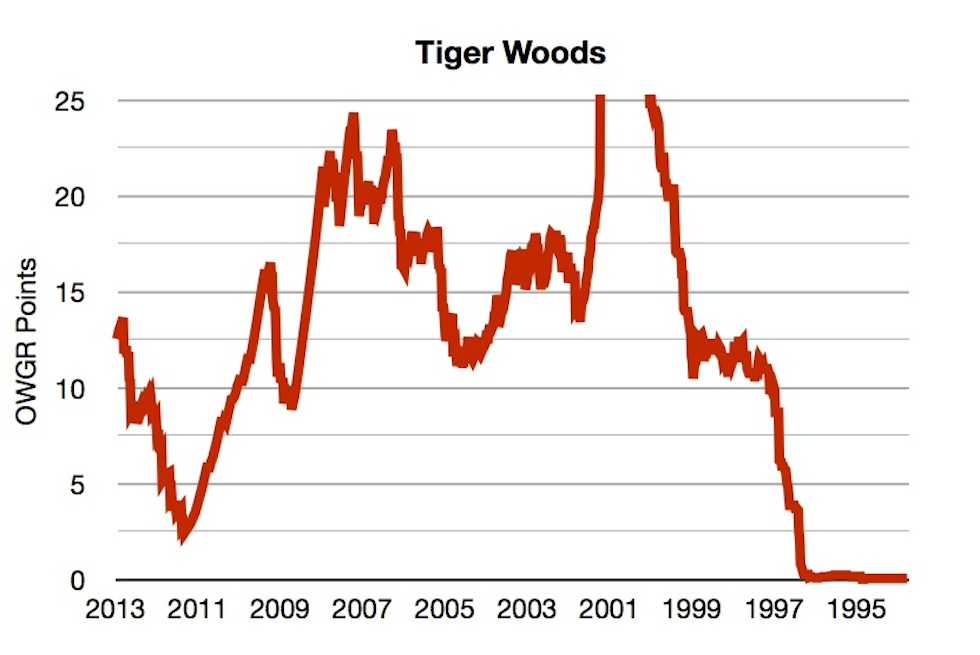
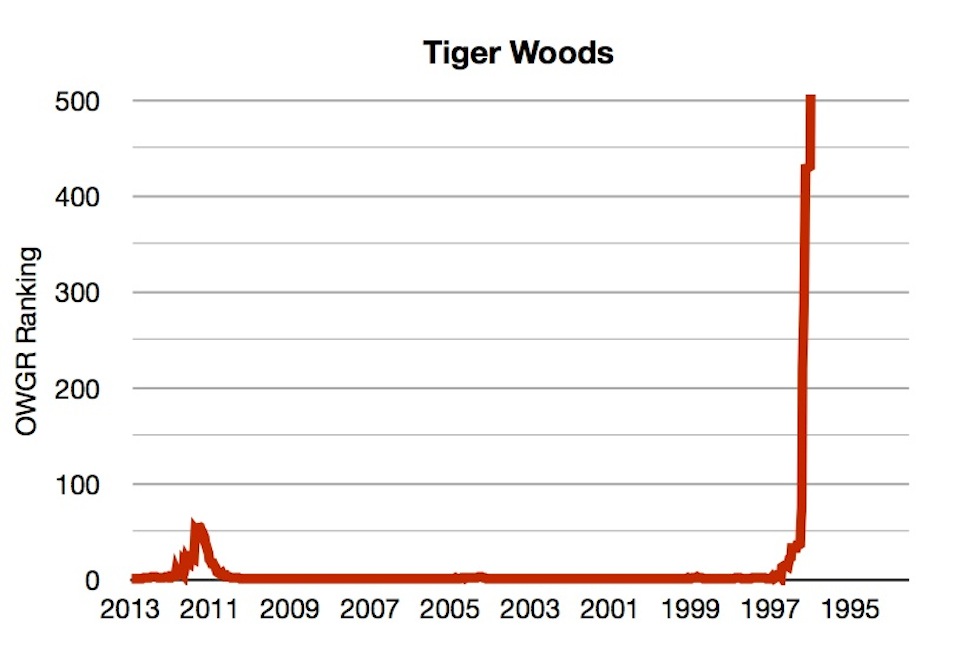
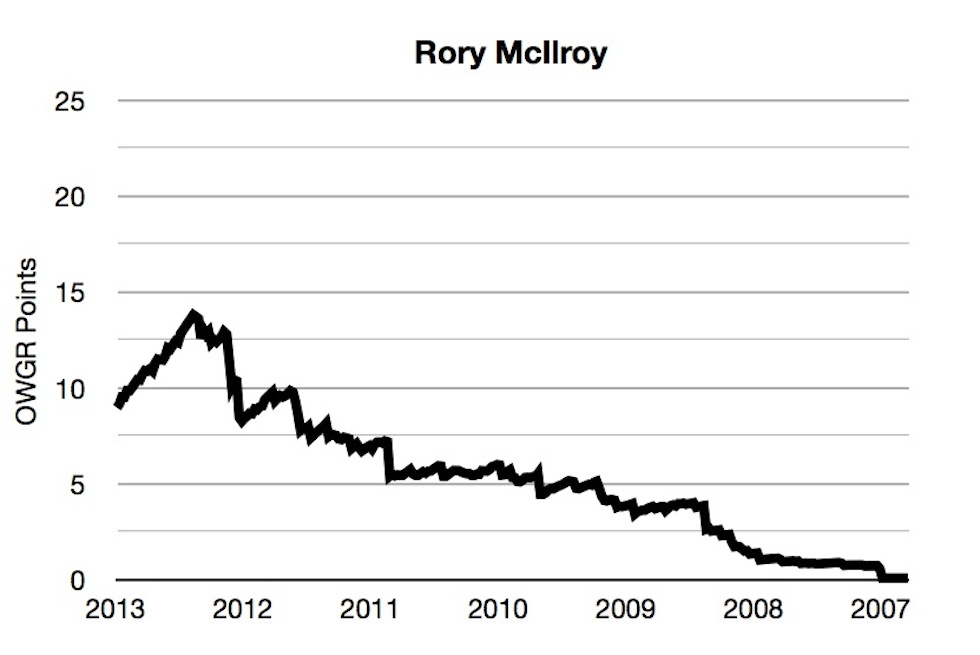

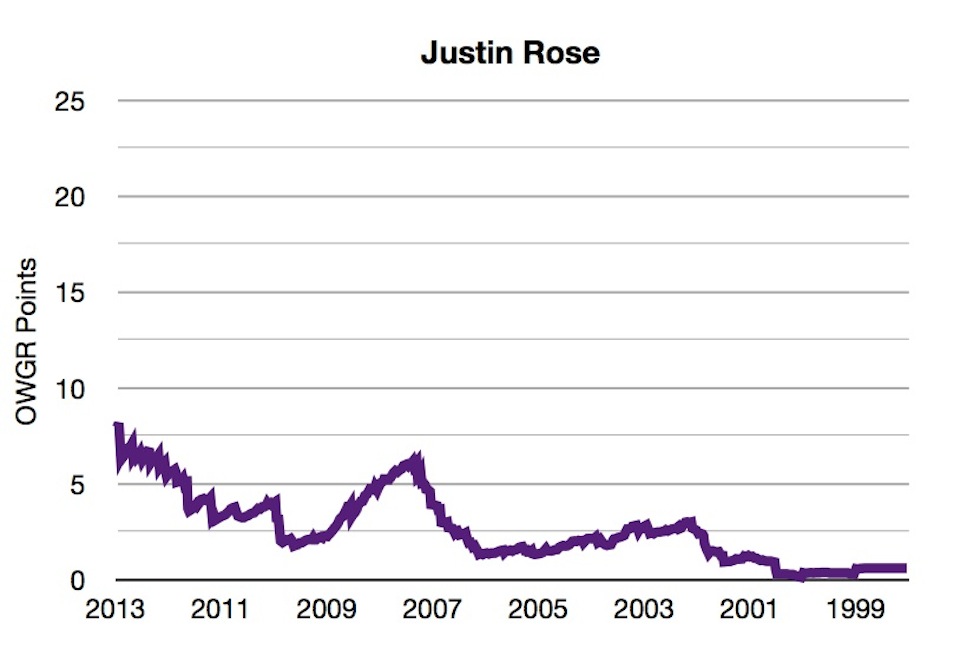
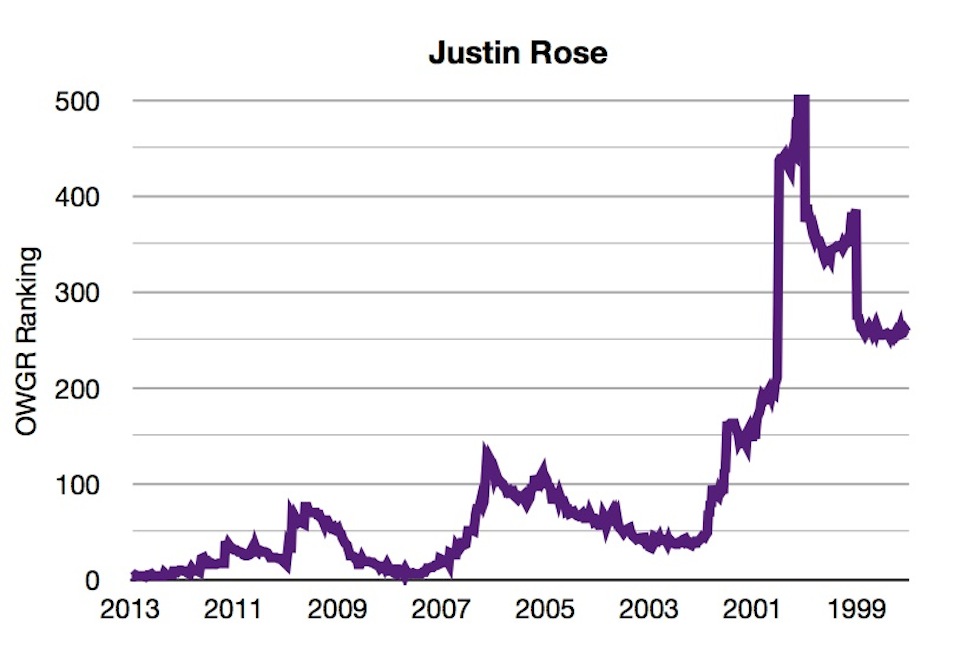
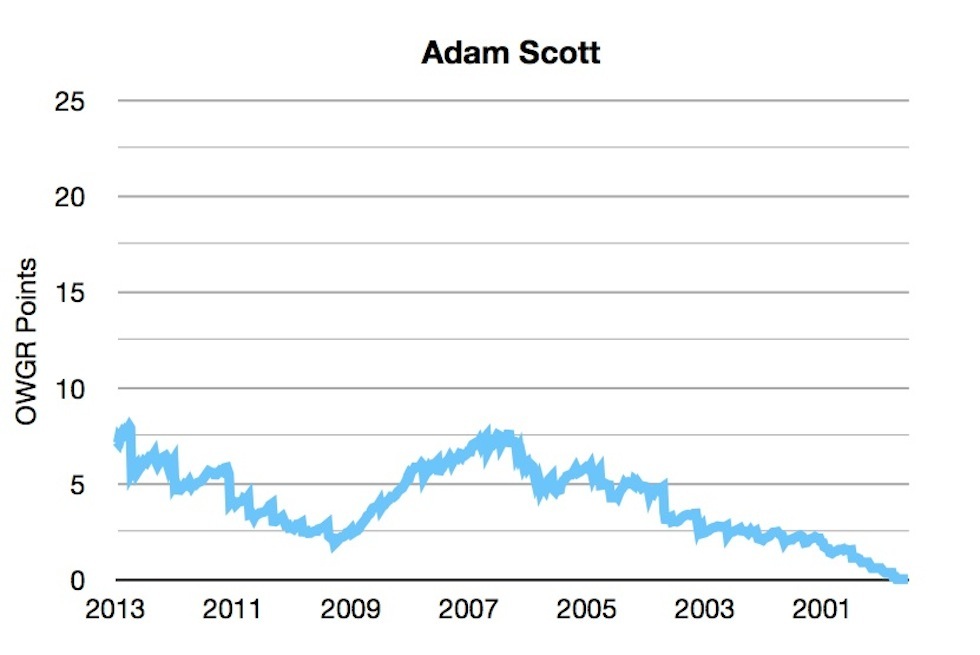
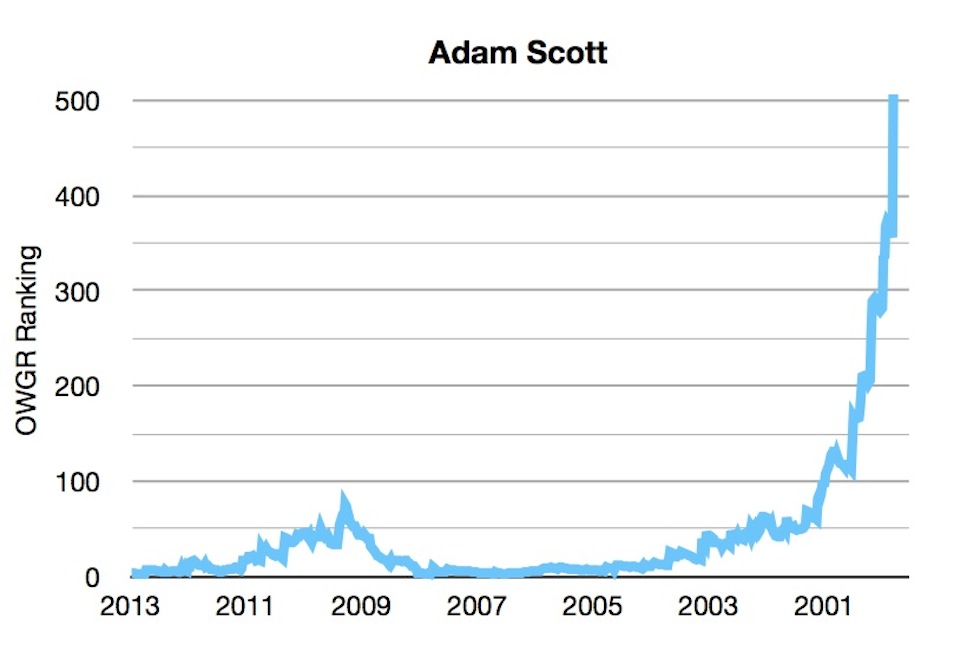
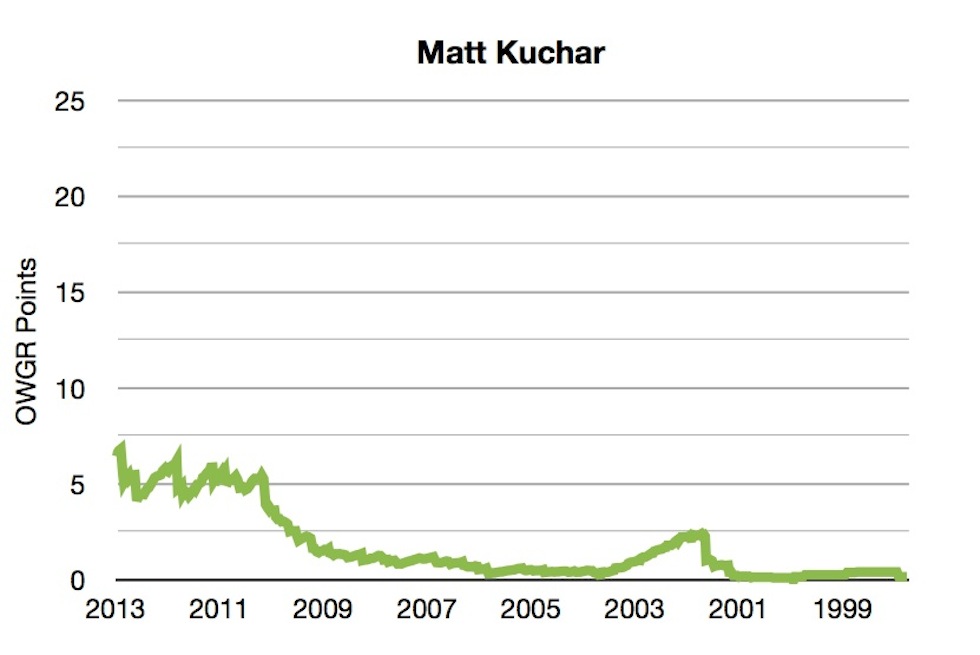
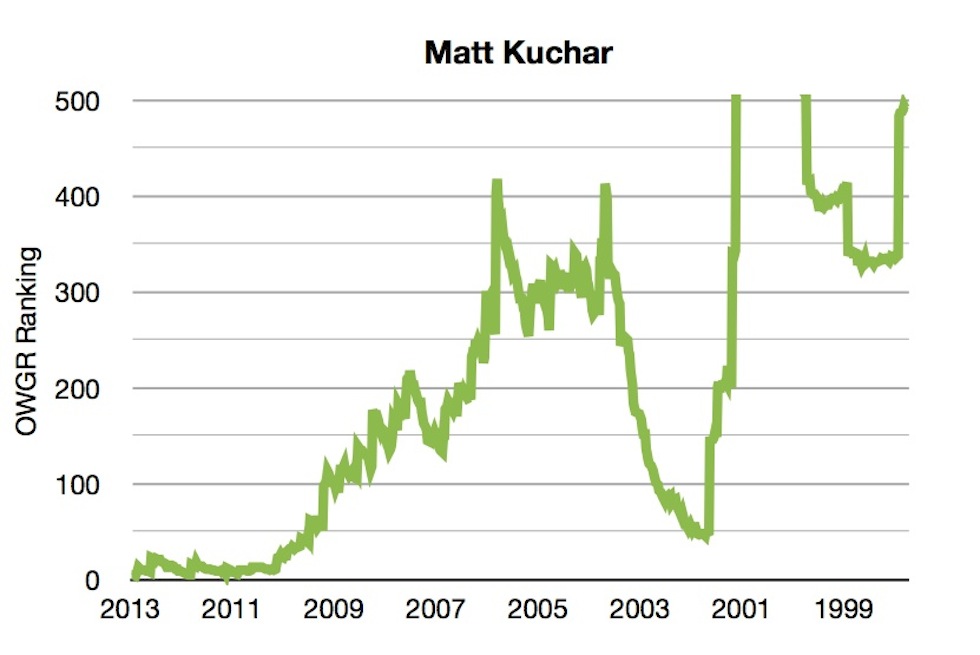


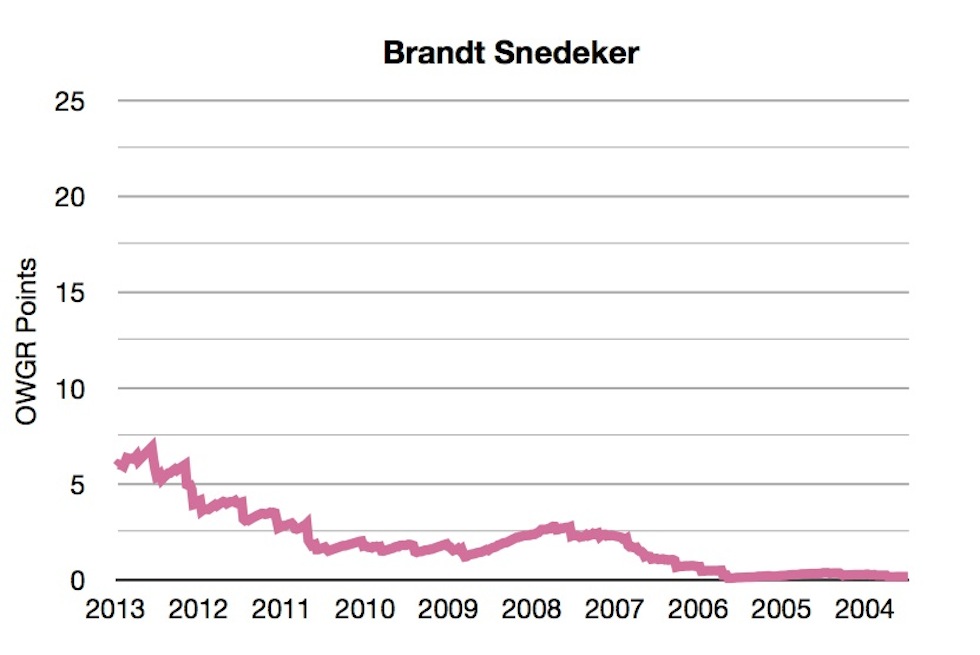
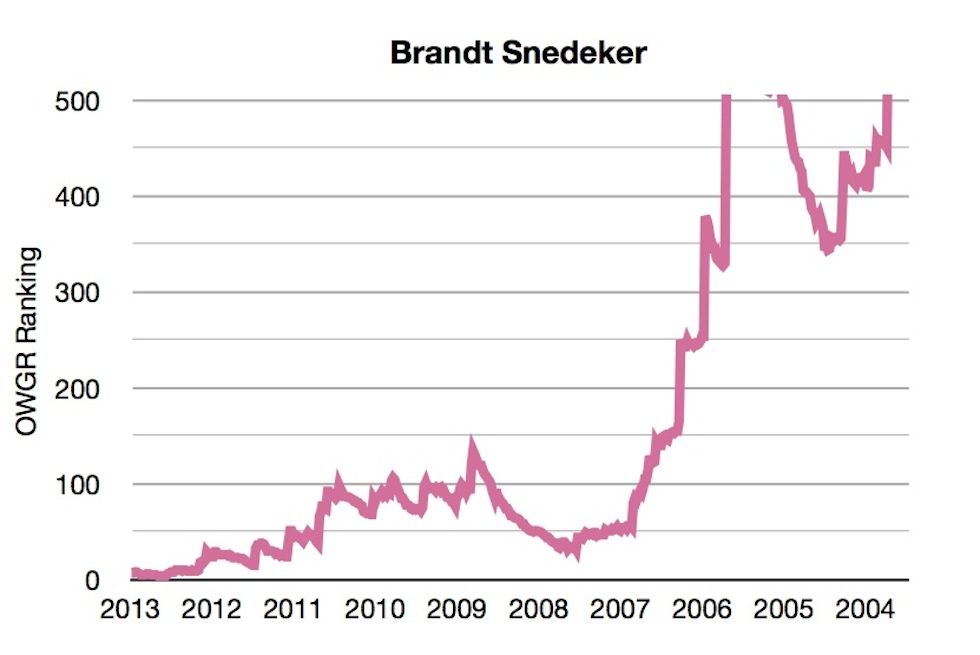
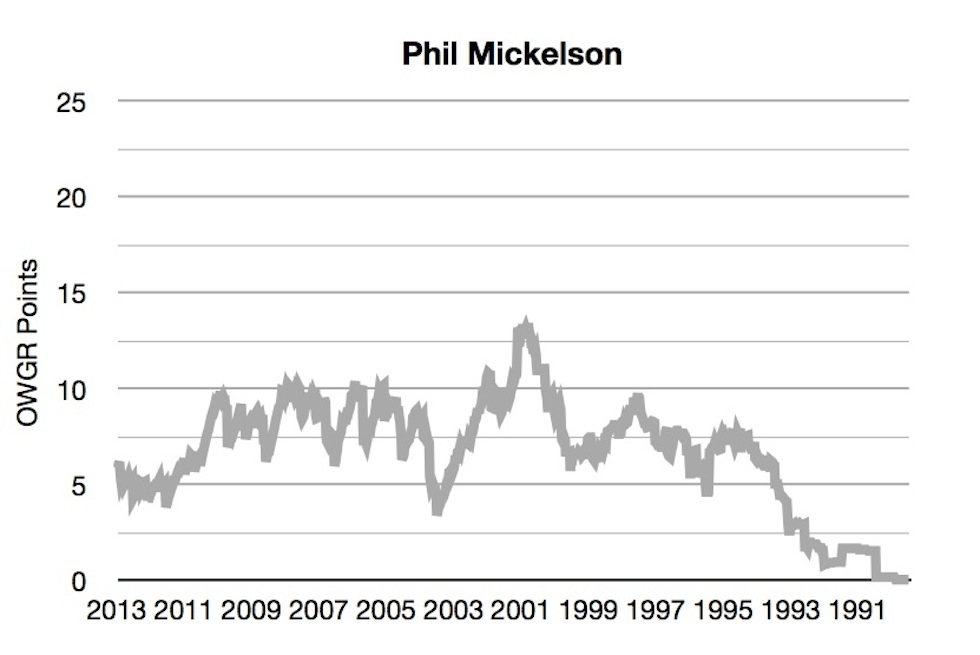
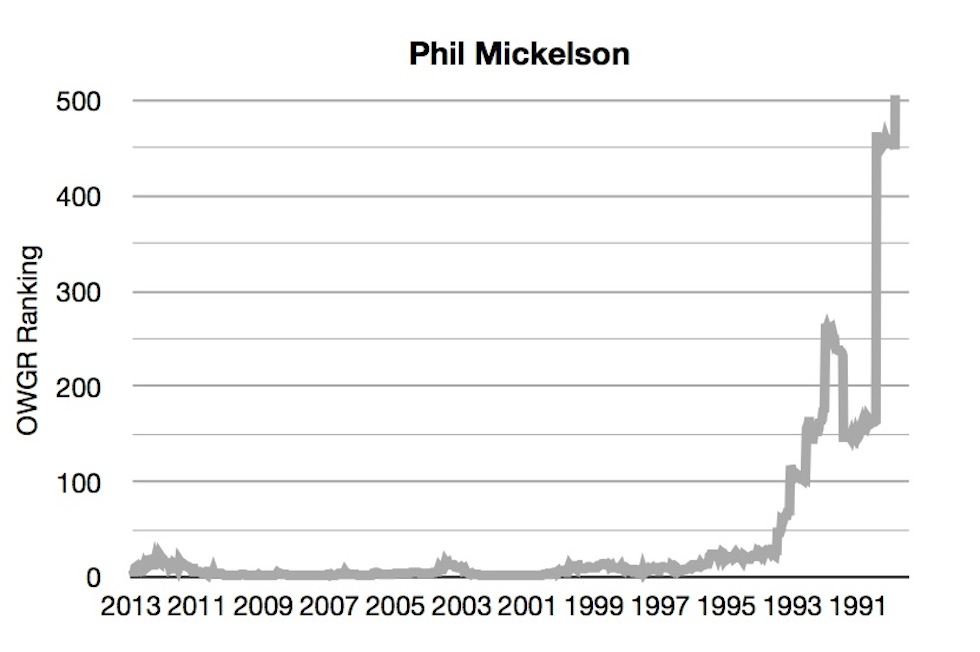

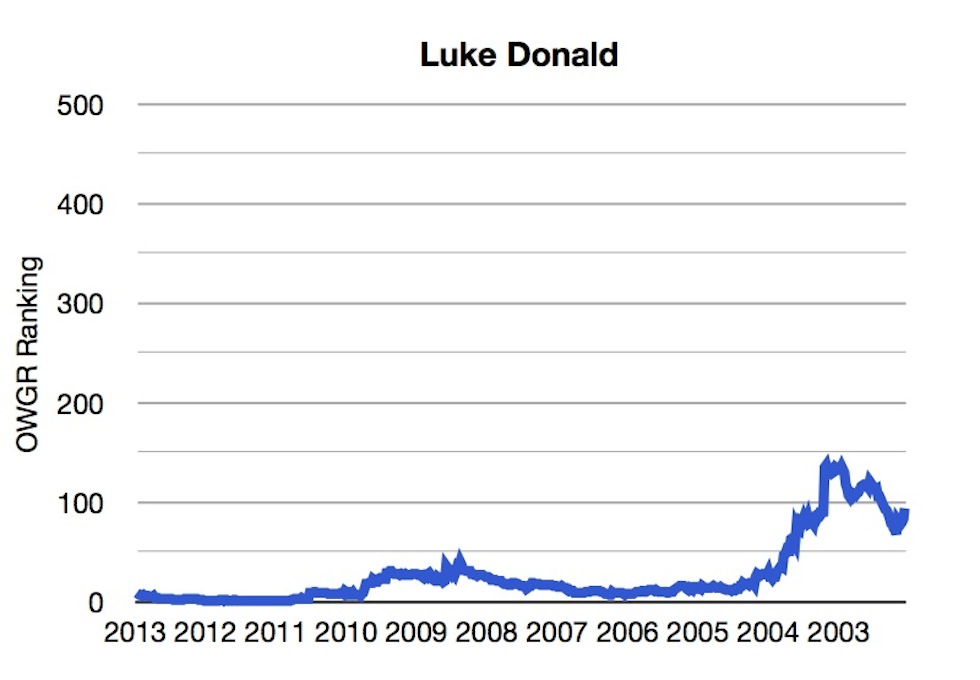

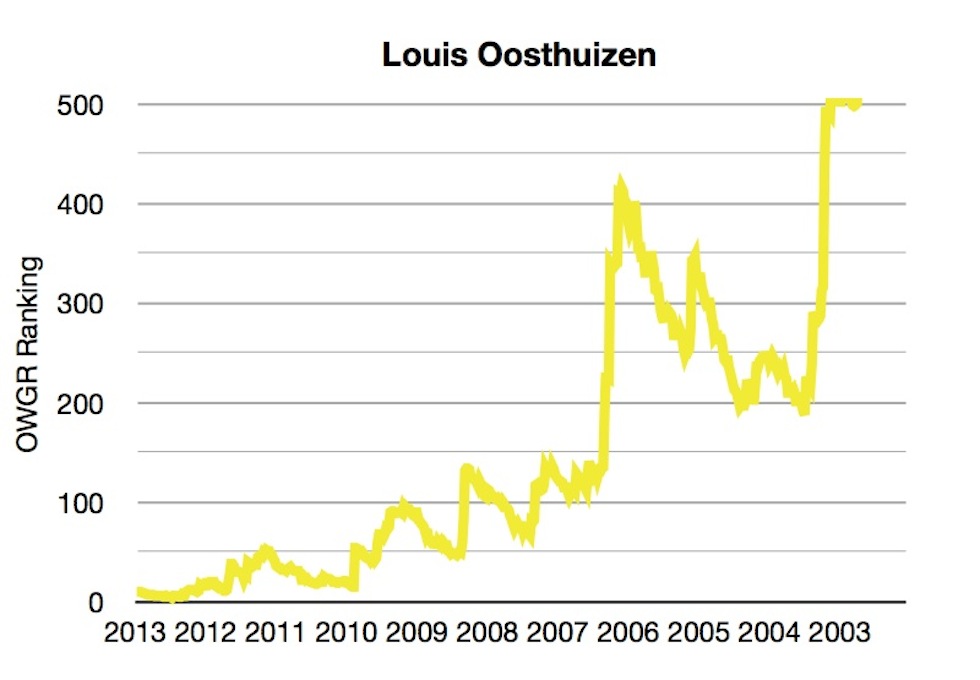
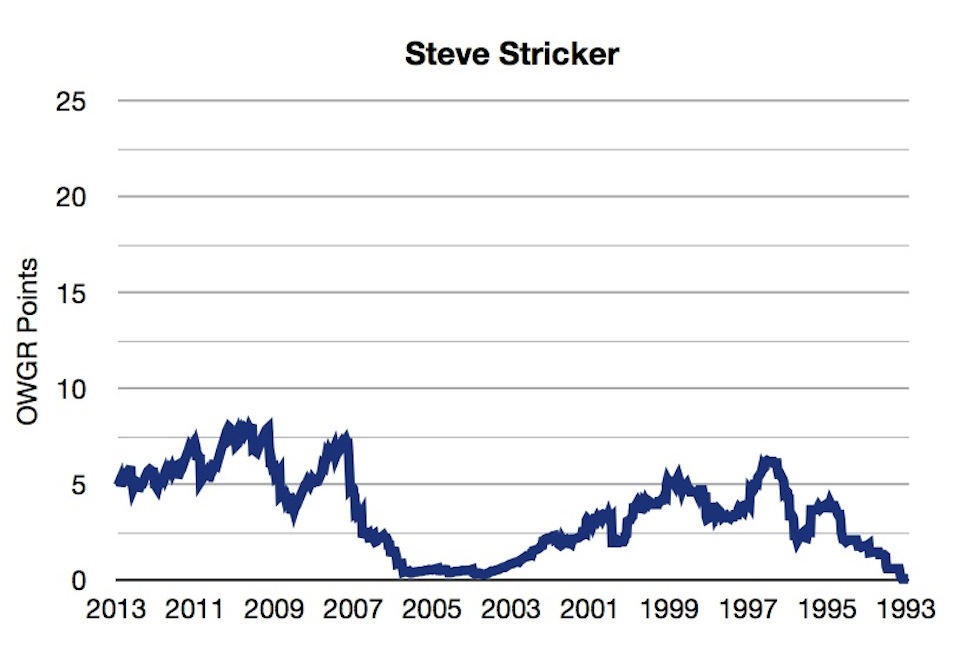
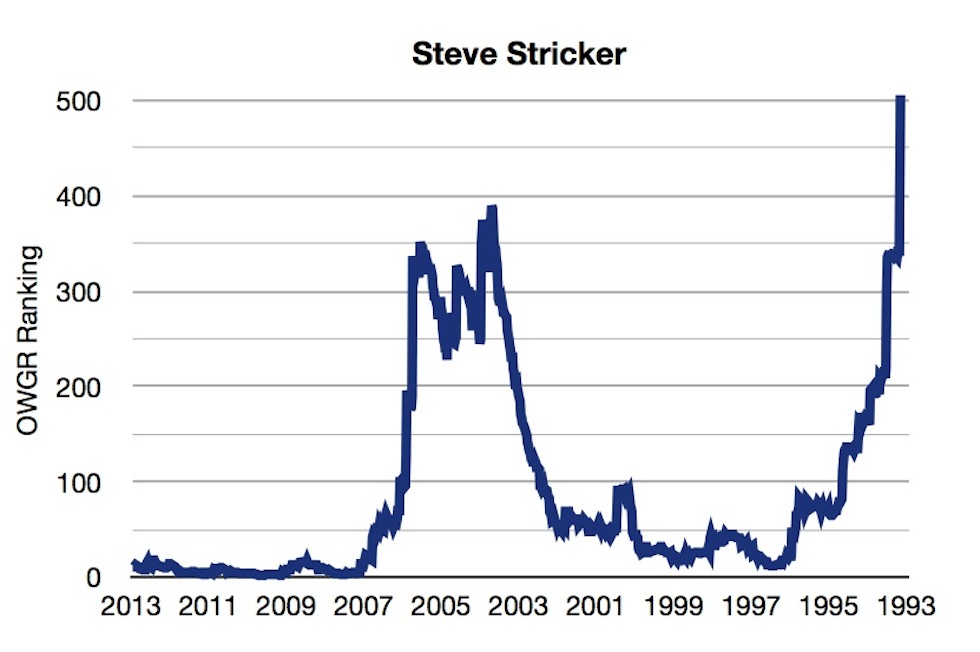
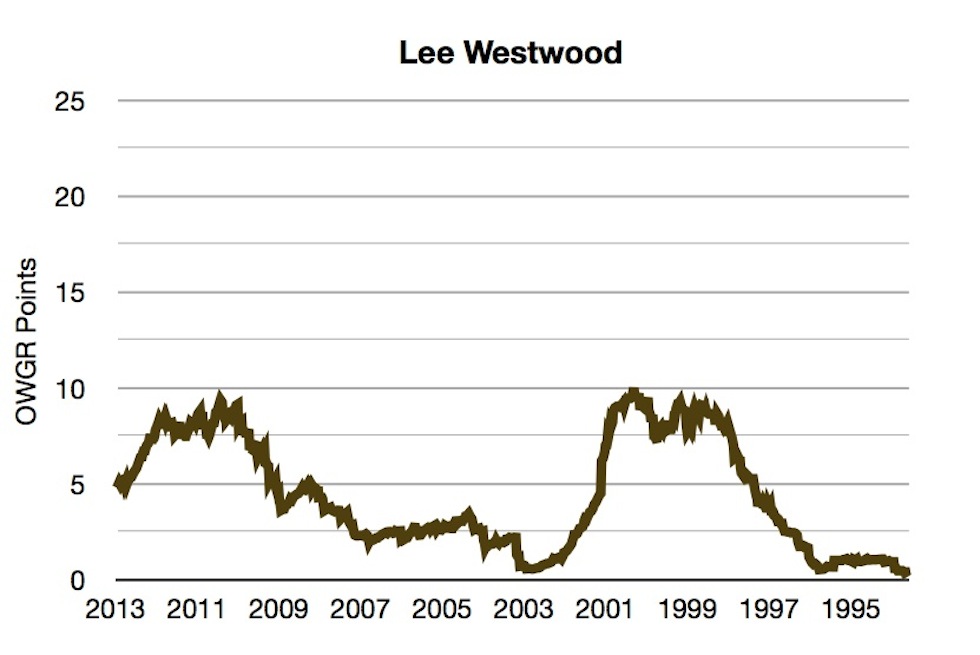
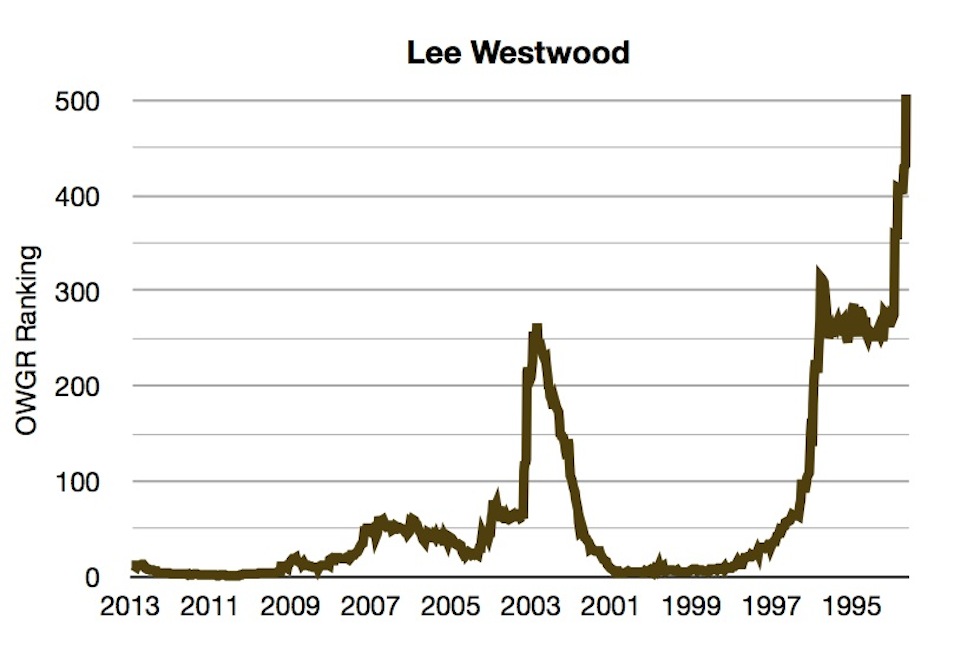
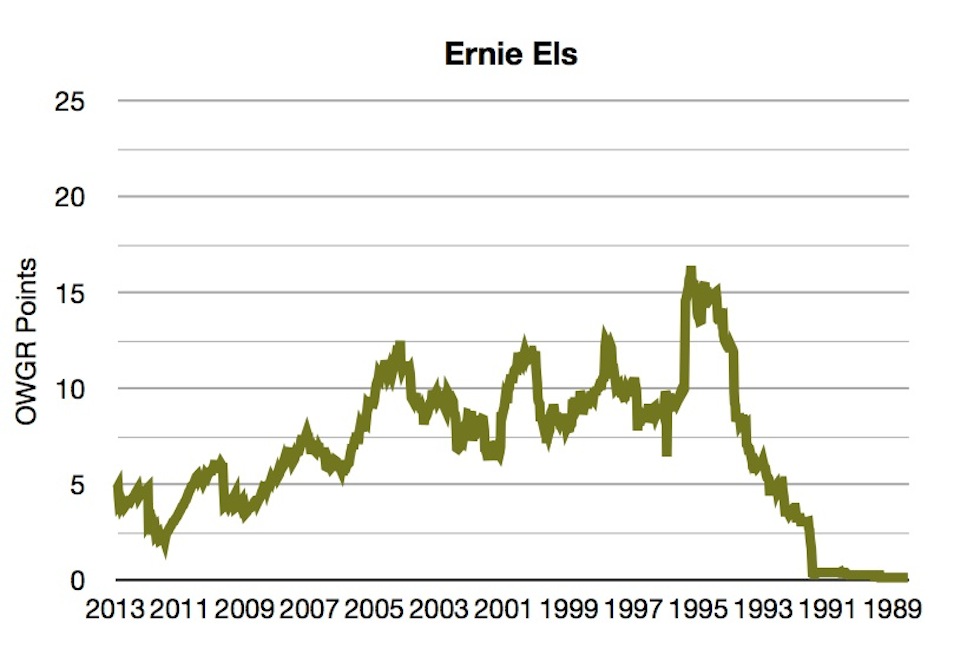
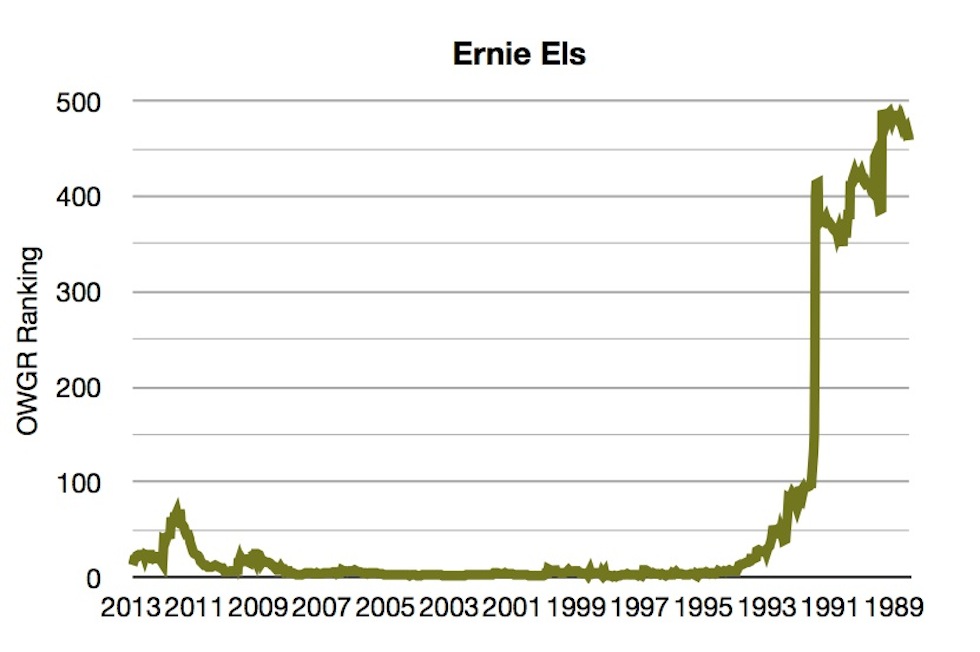
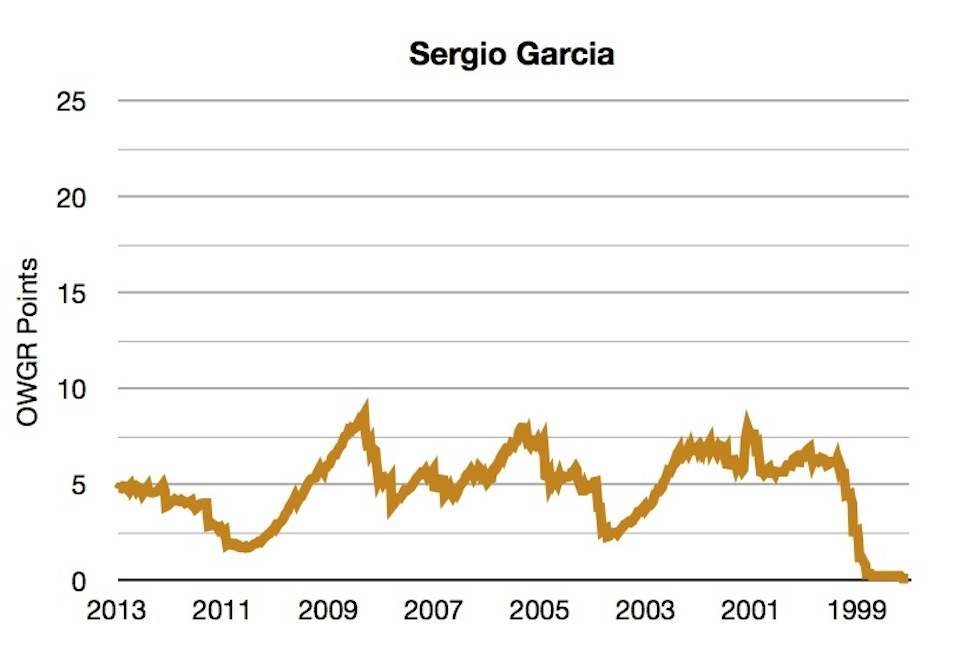
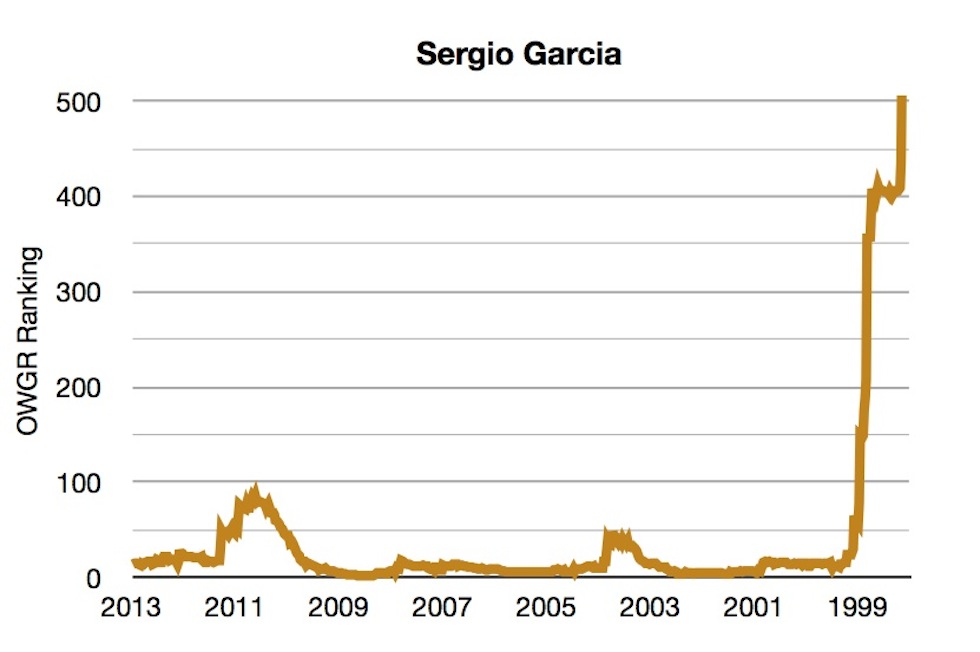
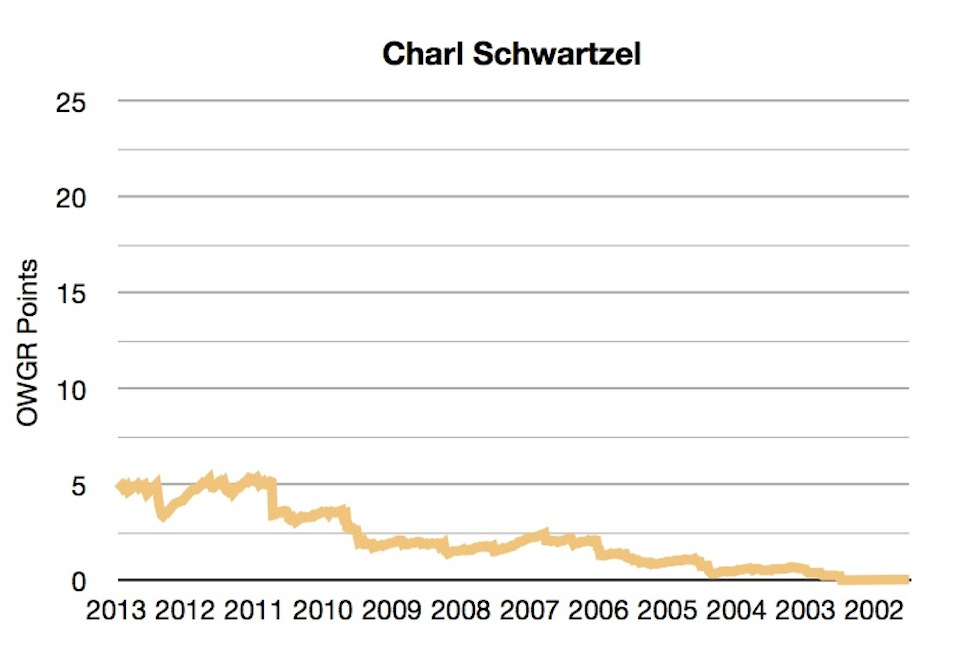
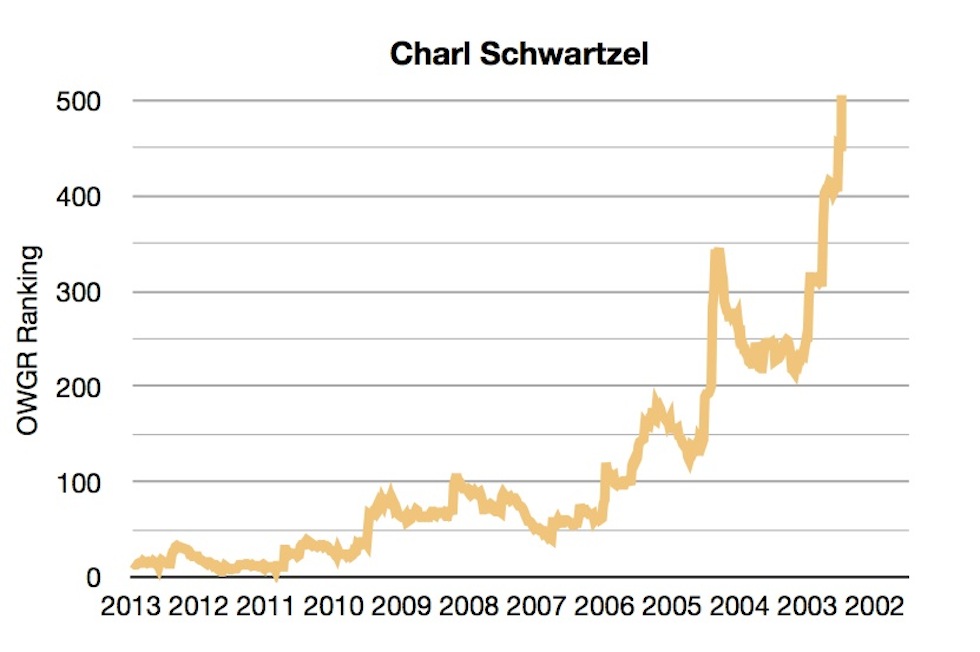
Thanks… interesting.